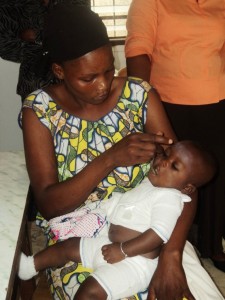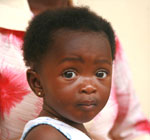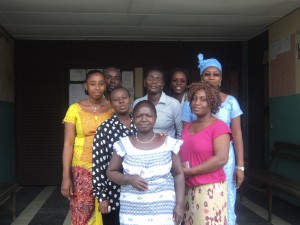Hadiya1 spoons warm porridge into six-month-old Aminah’s2 mouth and finds that on the first try, Aminah gobbles it up. Hadiya has learned the importance of introducing her daughter to porridge at six months, using nutrient-rich foods like soy flour, powdered milk, egg yolk, and peanut paste. She’s been coming to the Port Bouët II social center each week for several months—though she was forced to flee to her aunt’s village for a time, when the soldiers took over the center during the civil crisis. Côte d’Ivoire has endured a challenging past, with several civil wars and the more recent civil crisis following the disputed presidential election in November 2010 that caused widespread casualties, uprooted populations, and put a halt to development programs like the US Agency for International Development’s Infant & Young Child Nutrition (IYCN) Project.

Hadiya feeds her six-month-old daughter enriched porridge that she learned to make during a cooking demonstration at the Port Bouët II social center.
Since 2007, the IYCN Project has been working to prevent malnutrition of mothers and children younger than two years and to maximize HIV-free survival among children born to HIV-positive mothers. One of the project’s primary approaches to preventing malnutrition is reaching orphans and vulnerable children through government-supported social centers. IYCN works with national-level programs to train social workers in more than 30 centers throughout the country to monitor children’s growth and counsel caregivers on optimal infant and young child feeding practices, particularly within the context of HIV. In addition to counseling materials, the project supplies the centers with anthropometric equipment and cooking materials. At the heart of the community, social workers support community health workers to identify children with the highest risk of mortality—those who are severely acutely malnourished. The community health workers conduct home visits to see how caregivers are preparing enriched porridge for their moderately malnourished children, and encourage households to bring their children for monthly growth monitoring and promotion sessions at the social centers.
Hadiya explains how she likes to come to the social center to receive care that she knows is good for her child.
“I come here every week. This is my first child in ten years, and I want to protect her and keep her healthy,” she said.
Hadiya attends weekly cooking demonstrations to learn about new ways to prepare enriched porridge using locally available foods that she can afford. She explains that she will continue to breastfeed throughout the night and day and offer porridge in the morning and evening. Several mothers explain that before they started coming to the social center, they gave their children water because they thought they were thirsty. In talking with social workers, they learned that giving only breastmilk frequently was the perfect nourishment for their children until six months of age.
Having scales, height boards, and mid-upper arm circumference tapes has helped the social workers to better monitor children’s growth over time and to identify when a child has faltering growth or is already malnourished.
“[Before receiving equipment], we would look at physical characteristics, like edema and loose skin, to decide if a child was suffering from [severe] malnutrition,” remarked one social worker.
Another social worker explains that now during counseling sessions, she starts by looking at the child’s weight over time on the growth chart to determine if the child is growing well.
“When we see weights going up and down over time, we know there is something wrong. I ask what is going on: is your child sick, how do you feed, what do you feed?” she said.
She asks the caregiver about feeding practices: whether the child younger than six months is being exclusively breastfed; about breastfeeding positions; and when the child is older than six months, whether the child is given thin porridge made of cereal flour and water.
“I explain that giving this thin porridge will only make them sicker. Depending on the mother’s responses, I advise her,” the social worker explained.
After being trained on counseling caregivers about optimal feeding practices, the social workers feel more confident in their services.
“The training we received was very practical in that we learned to identify when a child wasn’t growing well and what to do about it. We learned about vitamins and what micronutrient deficiencies children are at risk of. I [now] counsel moms on choosing the salt with iodine in it, to keep oranges in the shade so the sun won’t destroy the vitamin C, and that palm oil is rich in vitamin A. We also learned to make thicker and enriched porridge by adding powdered milk or soy flour,” explained one social worker.
Another shares that “before [the training], we didn’t know we were making thin porridge and advised moms to start [breastfeeding] at four months.”
Now that the neighborhood is safe and the social center is running again, Hadiya says that she will continue to come to the social center to hear the various talks on family planning and nutrition, have her child weighed and immunized, and attend cooking demonstrations now that she has introduced solid food.
1The interviewee’s real name has not been used for protective purposes.
2The interviewee’s real name has not been used for protective purposes.
Photos: PATH/Jennifer Burns
Date: Feb 12, 2012 | Category: Success stories

